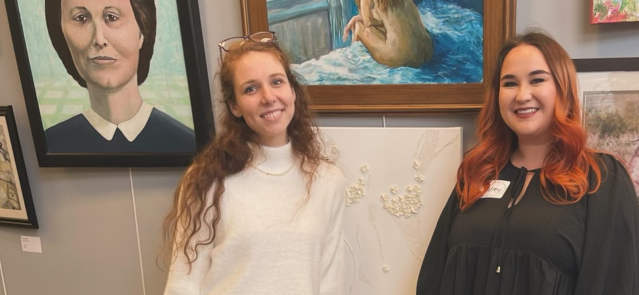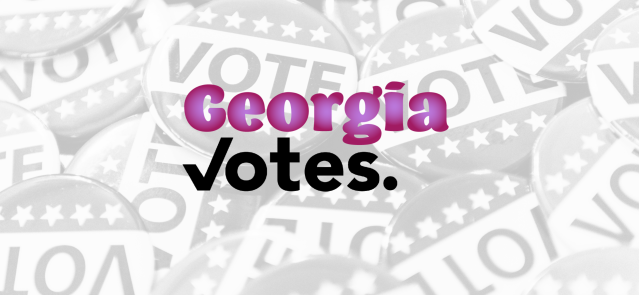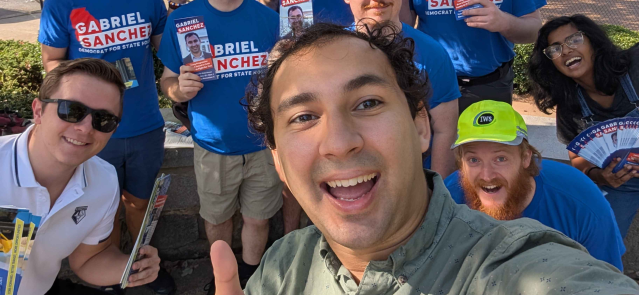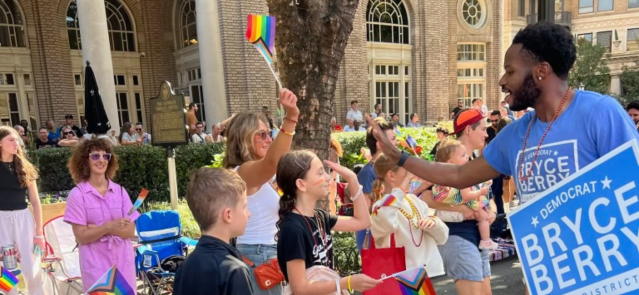Stay ahead of the curve as a political insider with deep policy analysis, daily briefings and policy-shaping tools.
Request a DemoAging out of foster care: ‘Everybody ain’t ready’
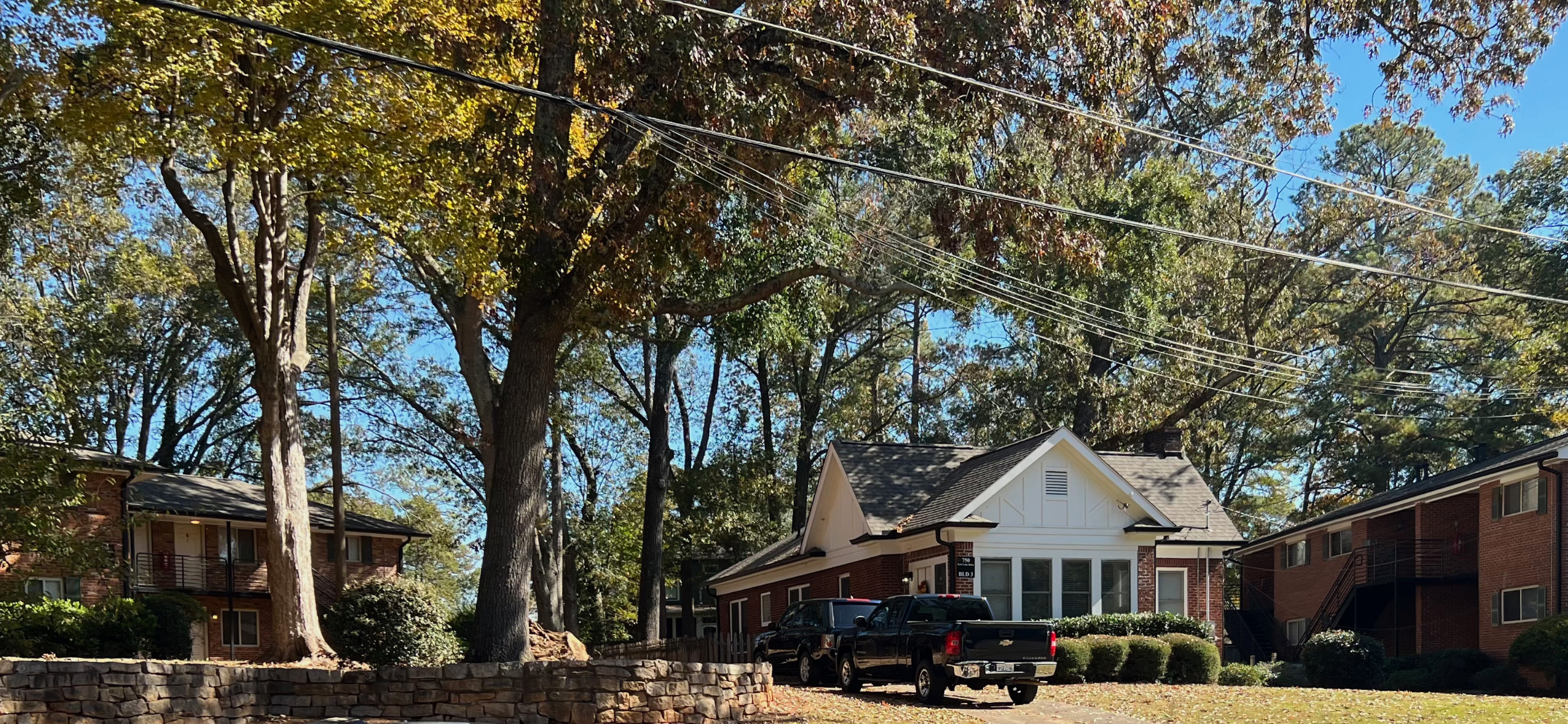
Wellroot Family Services facility in Decatur, GA. (Credit: Tammy Joyner)
Part 1 of a recurring series on the state’s foster care system and those aging out of it.
DECATUR — At first glance, the pair of red brick, two-story apartment buildings that bookend a small cottage in this quiet, neatly-manicured Decatur neighborhood are unassuming. Unremarkable, even.
But they are a pivotal part in helping a group of young people between the ages of 18 and 21 leave Georgia’s foster care system. For most of them, it’s the first time they will be on their own. No “family.” No more state supervision. None of the tools or life-skills family advice most people their age have at their disposal but sometimes take for granted. It’s a scary proposition for any young adult cutting the apron strings. Even more so for those who’ve never had a steady apron string.
The 14 young people living in the DeKalb County transitional life program — one of eight such programs in Georgia — are getting a crash-course on becoming adults and making it in the real world. Washing their own clothes, paying bills, cooking meals, even something as simple as boiling water is often foreign to them because they’ve been shuttled from foster home to group homes or other facilities during their time in foster care. They’re now learning those life skills they hadn’t picked up along the way through the transitional life program.
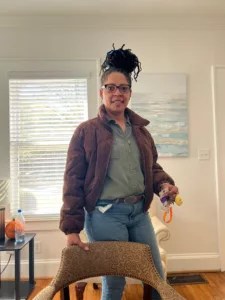
“Yeah, there’s a certain age you’re supposed to become an adult but everybody ain’t ready at that age,” Cotty Stanton Everhart told State Affairs during a visit to the Decatur facility.
The Decatur facility is run by Wellroot Family Services, Georgia’s longest-serving child welfare organization. The nonprofit has provided homes for the state’s at-risk children, teens, young adults and families for more than 150 years. Wellroot works with Georgia child welfare officials and is one of eight transitional living programs in the state for young people aging out of foster care. Options for young people over age 18 — the age at which a young person “ages out” of traditional foster care — include group home, extended foster care, college, transitional or independent living programs or a family member. Only a portion of young adults in extended foster care after the age of 18 are in transitional or independent living facilities.
Stanton Everhart is one of the adults in the Wellroot program helping young people become full-fledged adults. In her duties as first-shift lead, she is often mother, father, counselor and enforcer all wrapped into one. She has learned instinctively what motivates or comforts each young resident. For one, it may be something as simple as a fist bump. For someone else, it may be a takeout order of ribs for their birthday. Everhart has become adept at tag-team management, calling on colleagues to step in when she needs a hand.
“Sometimes the work you do here is enough and then sometimes the work you do over here is not enough. Sometimes you have to double-back or you have to tag somebody else in,” she said.
According to Connections Home, “every year, approximately 700 children will age out of the foster care system in Georgia, and 27,000 will age out nationwide.
“To put these numbers into perspective, the average public school in a suburban area contains around 656 students, and in the fall of 2020, the University of Georgia had 29,765 students enroll in their undergrad programs,” Connections Home proclaims on its website. “Imagine waking up one day to a school once full of smiling children suddenly barren, or a major university campus reduced to a few thousand stragglers. The students aren’t merely in quarantine or on break either — they’re just gone.”
Doing better than most
Programs like Wellroot have earned Georgia praise from national child welfare advocates.
“I think Georgia is doing better than many states in serving their eligible population of young people in transition from [foster] care,” said Todd Lloyd, senior policy associate at the Annie E. Casey Foundation, which recently released a comprehensive state-by-state look at what’s being done to help young people exit foster care.
Three in four, or 76%, of young people between the ages of 14 and 21 in foster care in Georgia received some sort of transition service — vocational training, help with housing or going to college or trade school — at some point compared to 47% of the rest of the country, the report found.
“You guys [Georgians] are making a very strong attempt to make sure that those who are served — you’re already serving three quarters — are getting some life skills training,” Lloyd told State Affairs. “You’re serving a much higher percentage of your young people than the national average.”
In fact, between 2016 and 2021, the latest available data, Georgia was among the top five states in the country providing life skills training for young people leaving foster care, the Casey report noted.
“You need practical life skills – such as money and time management – to navigate relationships, school work and life,” Lloyd said.
Yet, the Casey report noted Georgia needs to do better helping young people get and keep health insurance, finish high school, stay out of jail and pursue college, trade school or other advanced education. “The outcomes are not similar to other states in those areas,” Lloyd noted.
Case in point: postsecondary enrollment and incarceration.
“Nationally for the general population, 50% of 21-year-olds are enrolled in some sort of post secondary, half as many nationally for kids in foster care and half as much again for Georgia,” Lloyd said.
More than four in 10, or 41%, of young people in Georgia’s foster care system have experienced incarceration by the age of 21 versus 35% for young people in foster care in the rest of the country, the Casey report found.
Georgia has about 11,000 children in foster care, due to abuse, neglect, family drug addiction, violence, behavioral problems or other hardships. Georgia’s foster care system is stretched so thin that children spend about two years in the system — nearly three months longer than the national average of 21.7 months, according to The Council of State Governments Southern Office.
Black children make up a disproportionate number of children in the Georgia foster care system. In 2021, Blacks accounted for 34% of the state’s population but 43% of the foster care population, the Casey report noted.
“It is definitely very disproportionately Black,” Lloyd said. “And that is not uncommon. Unfortunately, there’s a lot of racial disproportionality. One of the most evident connections as a driver of child welfare system involvement is poverty. You’ll see that quite a few of your young people are entering [foster] care due to issues of neglect which are related to issues of poverty.”
This year, 539 young people turned 18 while in foster care in Georgia, according to Kylie Winton, a spokesperson for the Georgia Department of Human Services. They either signed themselves into the department’s custody voluntarily for extended youth services or they left foster care.
All told, 5.7% of the young people in Georgia foster care are between the ages of 18 and 21, Winton said. Although the state has extended foster care for young people to the age of 21, some are choosing to leave the system.
More Georgia youth “age out” of the system than the rest of the country. The Casey report found that 59% of Georgia foster kids age out versus 52% nationwide. Black and Hispanic youth disproportionately leave with no viable support, the report noted. Among 21 year olds, roughly 1 in 4 who left Georgia’s foster care system ended up homeless in 2021, according to the Casey report.
“I’m looking at this from a national perspective and, frankly, I don’t think we are serving kids exiting the foster system well as a nation,” said Bobby Cagle, a nationally recognized child welfare expert and former head of Georgia’s Department of Family and Children Services.
“If a kid’s very lucky, they’ll connect to some of the foster parents or they may have a mentor outside the system,” said Cagle, who now heads the child welfare division of Caresource, a nonprofit that provides public health programs such as Medicaid and Medicare. “Many don’t have that. As challenging as housing is today for a family, just think of a kid that’s going out trying to find a house with no credit history and no real resources.”
Getting reparations

Had it not been for her fiance helping with her bills and guidance from Wellroot’s transitional living program, Eshontee Rowe could have easily been a statistic in Georgia’s foster care system. Instead, she was able to navigate the complex foster care system and become the first in her family to finish high school and graduate from college.
Wellroot helped her find resources and other community agencies that led to her getting government money available for young people exiting foster care.
“Everything about Wellroot’s program screams independence and self-sufficiency,” said Rowe, who spent six years in the system after her mom decided that foster care would be the best way to get her the support she needed for her mental health challenges, she said. Before landing at Wellroot, she spent most of her teens shuttling between group homes.
“I was an articulate kid. I knew my rights. They thought I was being disrespectful for challenging them to make sure I got the services I needed. It caused me to be moved around a lot but ultimately I got what I needed.”
She recalled the time when she was living in a group home and in a dual-enrollment program taking high school and college classes.
“I couldn’t come back to the house [because house rules prevented anyone from being at the group home during school hours]. So I found myself riding around on the buses all the time because once I left the high school and went to the college campus, there was no meal plan for me.”
Now 26, Rowe is using her steadfastness to help other foster children. She is a child well-being advocate in Atlanta who understands how the system works now. She likens it to reparations.
“Get your reparation,” Rowe said, adding that the federal money, by way of Georgia, is available for young people leaving foster care to go to college, get an apartment and “get those extra funding opportunities and services.”
About $538 million in state and federal money is spent on Georgia’s foster care system. The bulk of that — $498.5 million — goes to intervention and late intervention programs, according to Voices for Georgia’s Children, a nonprofit child policy and advocacy group.
Addressing the needs of young adults leaving foster care is just one of many challenges within Georgia’s child welfare system which has come under state and federal scrutiny lately.
Earlier this year, lawmakers learned many of the hard-to-place children in Georgia’s foster care system – those with mental health challenges and other difficulties – were living in hotel rooms and offices because there was no place for them to go. In September, Georgia Department of Human Services Commissioner Candice Broce told the Senate Study Committee on Foster Care and Adoption that the foster care system had reached a milestone: No children were staying in hotels or offices, except in emergency cases.
But a report by Channel 2’s WSB-TV in November found that children had been “placed in group homes, private homes and, in some cases, overnight stays at DFCS offices.”
Meanwhile, Georgia’s own U.S. Sen. Jon Ossoff launched a bipartisan investigation last February after allegations surfaced that children in the care of Georgia’s Division of Family & Children Services had been abused and neglected. The hearings have highlighted testimony from former foster kids, parents, and experts into the treatment of foster children nationwide. Ossoff is chairman of the U.S. Senate Human Rights Subcommittee.
In the midst of that controversy is what Rowe considers the overlooked group of foster kids: the teenagers
“Unfortunately there are youth and kids in foster care that do not achieve what we call permanency,” Allison Ashe, Wellroot’s chief executive officer, told State Affairs.. They either don’t go back home to their families or become adopted or develop a permanent relationship with their foster parents. So they turn 18-years-old and they may have some connections in their lives but they don’t have somebody that can really guide them through that transition into young adulthood. Those kids face a lot of challenges.”
The pandemic has had a decisive impact on Georgia’s foster care system: Fewer young adults are opting to stay in foster care after the pandemic and fewer people are willing to be foster parents. Officials at Wellroot report seeing a 50% dip in available foster parents since the pandemic.
“I think people get a little nervous about fostering adolescents because adolescents get a bad rap,” Ashe said. “But adolescence is really an extraordinary time of life for a young person. They’re really working on their identity formation and figuring out who they are and to be a foster parent to those young people is such a gift.”
Changes ahead?
In the meantime, state lawmakers are trying to address problems with the child welfare system.
The Senate Study Committee on Foster Care and Adoption spent several months traveling the state this year listening to foster care kids, experts and agency workers on ways to fix the overburdened child welfare system.
“We got a lot of information that was not common knowledge to the committee,” said committee chair Sen. Kay Kirkpatrick, R-North-Central Cobb and West Cherokee.
The committee released its recommendations in November. Those findings, which include a mix of proposed legislation, budgetary matters and other remedies, will go before the Legislature when it reconvenes in January.
Among the suggestions:
- Getting foster kids into a permanent setup, whether through rejoining their family or adoption.
- Provide free, easily obtainable state photo IDs to foster children to make it easier for them to be able to drive and get jobs.
State officials in Georgia’s child welfare system say they are putting more focus on young people transitioning out of the system.
The state has independent living programs such as the Georgia Resilient Youth-Centered Stable and Empowered program or GA RYSE, Winton said. It helps young people prepare for adulthood through referral resources and connections within the community.
“We are working to strengthen services for youth transitioning to adulthood or aging out of the foster care system by partnering with youth advisory boards, agencies and community organizations,” Winton said.
GEORGIA’S FOSTER CARE: AT A GLANCE
Children in Georgia’s Department of Children and Family Services: 10,583
Average age of a child in foster care in Georgia: 8-years-old
Young adults (ages 18-21) in independent living programs in Georgia: 144
Young adults in transitional living programs in Georgia: 76
Young adults in other settings in Georgia: Over 400
Source: Georgia Department of Children and Family Services; State report, second quarter, 2023; Roo, Board & Watchful Oversight profile of agencies; the Annie E. Casey Foundation.
TOP 10 NEEDS FOR YOUTH EXITING FOSTER CARE
Navigating the foster care system is already difficult. Learning to navigate the real world after exiting the system presents another set of challenges. Here are 10 things every young person between the ages of 18 and 21 should know when leaving foster care, according to the Multi-Agency Alliance for Children.
- Enrollment in Health Insurance. Young people in foster care are automatically enrolled in Amerigroup Georgia Families 360 when they turn 18-years-old. Navigating the health care system, however, can be hard for those who don’t know how the system works. Young people need to understand how to stay enrolled and renew their coverage each year.
- Access to personal documents. Young people should have access to and copies of their official birth certificate, social security card, driver’s license or state identification, health insurance information, medical records and other vital papers. Young people also are entitled to a free copy of their credit report. They need to know their personal information is private and how to protect themselves from identity fraud and predatory financial services like payday loans.
- Written Transitional Living Plan. Young people are entitled to this plan, which helps them map out their transition from foster care.
- Connected by 21. Young people can stay in foster care until they turn 21 but can sign out at the age of 18. Advocates urge them to stay in care until 21 in order to have access to more resources and support.
- Know their rights. Youth should know what their rights and responsibilities are, in and after foster care. The Multi-Agency Alliance for Children helps young people understand what current laws and policies mean to them. The agency also can help with filing grievances.
- Post-secondary education. Those planning to attend college or trade school in Georgia can use the Educational Training Voucher to pay for it. But they must be high school graduates.
- Safe and stable housing. Finding a house can be daunting for young people. MAAC’s Beyond Fund supports emergency help for housing and other urgent needs of up to $300 per person.
- Reliable Transportation. Young people in foster care rely on agency staff rather than parents for rides. Once they leave the system, they often struggle to get to work, school or appointments because they don’t have reliable transportation.
- Financial Literacy. MAAC’s Opportunity Passport program is a matched savings program that helps young people improve their financial capability when transitioning from foster care or navigating other youth-serving systems.
- Support in times of need. Do you have somewhere to go during the holidays? Who can you call if you get sick or in a car accident? Do you have someone to talk to if you’re in an abusive relationship? Having permanent connections and relationships makes a big difference in being successful and on your own. MAAC works to make those connections possible. Find out more about MAAC here.
Have questions? Contact Tammy Joyner on X @lvjoyner or at [email protected].
And subscribe to State Affairs so you do not miss an update.
X @StateAffairsGA
Facebook @StateAffairsGA
Instagram @StateAffairsGA
LinkedIn @StateAffairs
Madeline Ryan Smith keeps it local as she aims to unseat incumbent in Georgia House District 158
Editor’s note: State Affairs spoke with the four Gen Z candidates running for the state Legislature in November as part of our “On the CampaignTrail” series. They discussed their campaigns and what they plan to do if elected. This profile looks at Georgia House District 158 candidate Madeline Ryan Smith. To read the main story …
A primer on the Nov. 5 ballot measures: What you need to know
In addition to voting for president and down-ballot candidates in the Nov. 5 election, Georgians will decide on a couple of tax measures and whether to create a statewide tax court. Three questions call for a statewide vote, all of which appear at the end of the ballot. The first time most voters see these …
From TikTok to door knocks: Gabriel Sanchez rallies young voters in House District 42 showdown
Editor’s note: State Affairs spoke with the four Gen Z candidates running for the state Legislature in November as part of our “On the CampaignTrail” series. They discussed their campaigns and what they plan to do if elected. This profile looks at Georgia House District 42 candidate Gabriel Sanchez. To read the main story for …
Bryce Berry schools the competition in Georgia House District 56 race
Editor’s note: State Affairs spoke with the four Gen Z candidates running for the state Legislature in November as part of our “On the CampaignTrail” series. They discussed their campaigns and what they plan to do if elected. This profile looks at Georgia House District 56 candidate Bryce Berry. To read the main story for …

